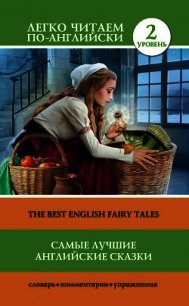Celtic Fairy Tales - Jacobs Joseph (бесплатные онлайн книги читаем полные TXT) 📗
XXIII. ANDREW COFFEY.
Source.–From the late D. W. Logie, written down by Mr. Alfred Nutt.
Parallels.–Dr. Hyde’s “Teig O’Kane and the Corpse,” and Kennedy’s “Cauth Morrisy,” Legend. Fict., 158, are practically the same.
Remarks.–No collection of Celtic Folk-Tales would be representative that did not contain some specimen of the gruesome. The most effective ghoul story in existence is Lover’s “Brown Man.”
XXIV. BATTLE OF BIRDS.
Source.–Campbell (Pop. Tales, W. Highlands, No. ii.), with touches from the seventh variant and others, including the casket and key finish, from Curtin’s “Son of the King of Erin" (Myths, &c., 32 seq.). I have also added a specimen of the humorous end pieces added by Gaelic story-tellers; on these tags see an interesting note in MacDougall’s Tales, note on p. 112. I have found some difficulty in dealing with Campbell’s excessive use of the second person singular, “If thou thouest him some two or three times, ’tis well,” but beyond that it is wearisome. Practically, I have reserved thou for the speech of giants, who may be supposed to be somewhat old-fashioned. I fear, however, I have not been quite consistent, though the you’s addressed to the apple-pips are grammatically correct as applied to the pair of lovers.
Parallels.–Besides the eight versions given or abstracted by Campbell and Mr. Curtin’s, there is Carleton’s “Three Tasks,” Dr. Hyde’s “Son of Branduf” (MS.); there is the First Tale of MacInnes (where see Mr. Nutt’s elaborate notes, 431-43), two in the Celtic Magazine, vol. xii., “Grey Norris from Warland” (Folk-Lore Journ. i. 316), and Mr. Lang’s Morayshire Tale, “Nicht Nought Nothing” (see Eng. Fairy Tales, No. vii.), no less than sixteen variants found among the Celts. It must have occurred early among them. Mr. Nutt found the feather-thatch incident in the Agallamh na Senoraib ("Discourse of Elders”), which is at least as old as the fifteenth century. Yet the story is to be found throughout the Indo-European world, as is shown by Prof. Kohler’s elaborate list of parallels attached to Mr. Lang’s variant in Revue Celtique, iii. 374; and Mr. Lang, in his Custom and Myth ("A far travelled Tale”), has given a number of parallels from savage sources. And strangest of all, the story is practically the same as the classical myth of Jason and Medea.
Remarks.–Mr. Nutt, in his discussion of the tale (MacInnes, Tales 441), makes the interesting suggestion that the obstacles to pursuit, the forest, the mountain, and the river, exactly represent the boundary of the old Teutonic Hades, so that the story was originally one of the Descent to Hell. Altogether it seems likely that it is one of the oldest folk-tales in existence, and belonged to the story-store of the original Aryans, whoever they were, was passed by them with their language on to the Hellenes and perhaps to the Indians, was developed in its modern form in Scandinavia (where its best representative “The Master Maid” of Asbjornsen is still found), was passed by them to the Celts and possibly was transmitted by these latter to other parts of Europe, perhaps by early Irish monks (see notes on “Sea-Maiden”). The spread in the Buddhistic world, and thence to the South Seas and Madagascar, would be secondary from India. I hope to have another occasion for dealing with this most interesting of all folk-tales in the detail it deserves.
XXV. BREWERY OF EGGSHELLS.
Source.–From the Cambrian Quarterly Magazine, 1830, vol. ii. p. 86; it is stated to be literally translated from the Welsh.
Parallels.–Another variant from Glamorganshire is given in Y Cymmrodor, vi. 209. Croker has the story under the title I have given the Welsh one in his Fairy Legends, 41. Mr. Hartland, in his Science of Fairy Tales, 113-6, gives the European parallels.
XXVI. LAD WITH THE GOAT SKIN.
Source.–Kennedy, Legendary Fictions, pp. 23-31. The Adventures of “Gilla na Chreck an Gour’.”
Parallels.–"The Lad with the Skin Coverings” is a popular Celtic figure, cf. MacDougall’s Third Tale, MacInnes’ Second, and a reference in Campbell, iii. 147. According to Mr. Nutt (Holy Grail, 134), he is the original of Parzival. But the adventures in these tales are not the “cure by laughing” incident which forms the centre of our tale, and is Indo-European in extent (cf. references in English Fairy Tales, notes to No. xxvii.). "The smith who made hell too hot for him is Sisyphus,” says Mr. Lang (Introd. to Grimm, p. xiii.); in Ireland he is Billy Dawson (Carleton, Three Wishes). In the Finn-Saga, Conan harries hell, as readers of Waverley may remember “’Claw for claw, and devil take the shortest nails,’ as Conan said to the Devil" (cf. Campbell, The Fians, 73, and notes, 283). Red-haired men in Ireland and elsewhere are always rogues (see Mr. Nutt’s references, MacInnes’ Tales, 477; to which add the case in “Lough Neagh,” Yeats, Irish Folk-Tales, p. 210).


